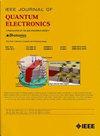Bidirectional Controlled Assisted Cloning of Arbitrary Unknown Single-Qudit States
IF 2.2
3区 工程技术
Q3 ENGINEERING, ELECTRICAL & ELECTRONIC
引用次数: 0
Abstract
By making use of d-dimensional Hadamard gates and d-dimensional controlled NOT gates, we first construct a five-qudit maximally entangled state, and then use it as the quantum channel to propose a new bidirectional scheme for cloning two different arbitrary unknown single-qudit simultaneously under the assistance from a state preparer and the control of a supervisor. This scheme consists of two stages: quantum teleportation and assisted cloning. To fulfil the purpose, the first stage of this scheme requires bidirectional controlled teleportation via our constructed five-qudit maximally entangled state as quantum channel, where two distant communicators can simultaneously exchange their unknown single-qudit states with unit fidelity and unit probability under the permission of the supervisor.In the second stage,the state preparer disentangles any remaining entangled states by introducing two auxiliary particles, implementing a unitary transformation and two single-particle projective measurements. Subsequently, they transmit a specific number of classical bits to two distinct communicators in order to generate two precise replicas of different unknown states. Subsequently, the above scheme is extended with a certain probability and unit fidelity by replacing the above d-dimensional quantum channel with a five-qudit non-maximally entangled state. Finally, we further analyze the expansion issues of our scheme from the perspectives of positive operator-valued measurement (POVM for short), general quantum channel and the number of state preparers and controllers, and point out that the scheme is secure.双向受控辅助克隆任意未知单Qudit状态
通过利用 d 维哈达玛门和 d 维受控 NOT 门,我们首先构建了一个五比特最大纠缠态,然后将其作为量子信道,提出了一种新的双向方案,即在状态准备者的协助和监督者的控制下,同时克隆两个不同的任意未知单比特。该方案包括两个阶段:量子远距传输和辅助克隆。为了实现这一目的,该方案的第一阶段需要通过我们构建的五比特最大纠缠态作为量子信道进行双向受控远距传输,在这一阶段,两个遥远的通信者可以在监督者的允许下,以单位保真度和单位概率同时交换他们的未知单比特态。随后,他们向两个不同的通信器传输特定数量的经典比特,以生成两个不同未知状态的精确复制品。随后,将上述 d 维量子信道替换为五比特非最大纠缠态,以一定的概率和单位保真度对上述方案进行扩展。最后,我们从正算子值测量(简称 POVM)、一般量子信道以及状态准备者和控制者的数量等角度进一步分析了我们方案的扩展问题,并指出该方案是安全的。
本文章由计算机程序翻译,如有差异,请以英文原文为准。
求助全文
约1分钟内获得全文
求助全文
来源期刊

IEEE Journal of Quantum Electronics
工程技术-工程:电子与电气
CiteScore
4.70
自引率
4.00%
发文量
99
审稿时长
3.0 months
期刊介绍:
The IEEE Journal of Quantum Electronics is dedicated to the publication of manuscripts reporting novel experimental or theoretical results in the broad field of the science and technology of quantum electronics. The Journal comprises original contributions, both regular papers and letters, describing significant advances in the understanding of quantum electronics phenomena or the demonstration of new devices, systems, or applications. Manuscripts reporting new developments in systems and applications must emphasize quantum electronics principles or devices. The scope of JQE encompasses the generation, propagation, detection, and application of coherent electromagnetic radiation having wavelengths below one millimeter (i.e., in the submillimeter, infrared, visible, ultraviolet, etc., regions). Whether the focus of a manuscript is a quantum-electronic device or phenomenon, the critical factor in the editorial review of a manuscript is the potential impact of the results presented on continuing research in the field or on advancing the technological base of quantum electronics.
 求助内容:
求助内容: 应助结果提醒方式:
应助结果提醒方式:


